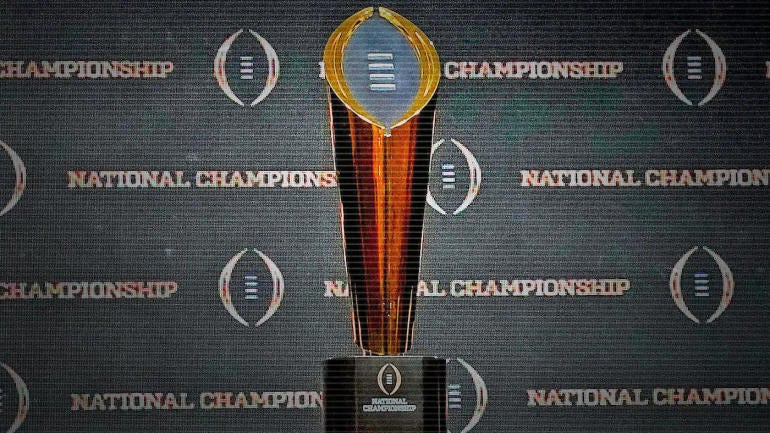
There's a chance they're going to screw up expansion. It's the only way explain what's happening with the folks overseeing College Football Playoff augmentation.
Look, these commissioners and athletic directors are all great people. They're smart. But even they have to see that progress on expansion is grinding to a slow halt as if someone has thrown sand in the gears.
The first CFP Rankings come out Tuesday night. Starting Wednesday in Irving, Texas, the CFP stakeholders begin a two-day meeting to do … what, exactly? Almost seven months after the CFP first dropped a 12-team expansion hint, there is no consensus on where it is headed. Not even close.
In fact, a fracture appeared publicly when the Sports Business Journal reported over the weekend the "alliance" conferences -- Big Ten, ACC, Pac-12 -- favor an eight-team model.
One problem? The math doesn't work.
Inside the current CFP contract, ESPN doesn't have to pay a dime more for an eight-team field because there would be the same amount of games there are now: seven. It's just that, as of now, four of the seven games are called New Year's Six bowls. In an eight-team bracket, all seven would be playoff games.
Eight teams will not be adopted because Notre Dame, for one, won't approve amid access concerns. Plus, Fighting Irish AD Jack Swarbrick worked for two years with three other colleagues to develop the 12-team bracket.
Forget a consensus, there may not even be a general agreement. Any expansion decision must be unanimous among the 11 FBS commissioners and Notre Dame.
Eight teams would also limit Group of Five access … at least compared to what we came to accept in the 12-team bracket developed by Swarbrick, SEC commissioner Greg Sankey, Big 12 commissioner Bob Bowlsby and Mountain West commissioner Craig Thompson.
Twelve teams tripled the field. It was all-inclusive. Then suddenly, after a few conferences got their feelings hurt, it wasn't.
What's become obvious over the last few months is that it's either four or 12. There is no in-between.
"We will end up staying at four," a person intimately involved in the talks told CBS Sports over the weekend.
Sankey has said as much to media: The playoff will remain status quo or go to 12 team. He has long been on board with the current four-team model. He has no reason not to be. The SEC has the best -- and so far only -- chance of getting multiple programs into a four-team bracket.
"I think four has worked, is working and can continue to work," Sankey said before the Florida-Georgia game. "So, it's four or 12."
That's ominous and depressing. If so, then what has this process been about? These past few months have been the Big Tease with talk of expansion and access and dollars and maybe -- just maybe -- an honest-to-goodness Cinderella team one day emerging in a sport that does not welcome them.
There are agendas now out the wazoo. Bowl Season wants all the games played in bowls. The Big Ten and Pac-12 want to take care of the Rose Bowl. If a Big Ten team qualifies for the first round, it might have to play in an NFL stadium instead of on its own campus because of weather. There are those who want the current contract to run out in five years so the bidding can go through the roof. Who can blame them?
College football is now the only major sport that doesn't split up its championship postseason among multiple networks. Even the NCAA Tournament has a deal with CBS and Turner.
For now, if the CFP decides to expand to 12 within the current contract, ESPN would have to pay for it. It's written into the contract language that still has five years left to run. That has not been previously reported.
The presumption is a revenue infusion would be substantial. Sports Illustrated reported the CFP would get a combined $450 million for the 2024 and 2025 seasons with a 12-team bracket.
So, in essence, it's not a TV negotiation if the bracket expands inside the current contract. The CFP could expand and get a defined revenue bump just by flipping that unanimous switch.
If only it was that easy.
Now, if the CFP lets its contract expire and takes their property into the open market, that $450 million increase could be a $1 billion increase in a heartbeat.
The earliest expansion could happen is 2024, (that's when the current ESPN deal reportedly can be amended). But a decision -- reminder: unanimous decision -- would have to come in the next three or four months.
As things look now, that's just not likely. If expansion is not put into place now, it would not begin until 2026 at the earliest. That might upset fans who were conditioned by an earlier CFP press release that threw 2023 out there as a possible starting date.
CBS Sports has been told the Pac-12 actually does support a 12-team bracket with minor changes. As proposed by the CFP Management Committee in June, the Rose Bowl could already have a spot in the quarterfinals with one of both teams from the Pac-12 and Big Ten. A 12-team playoff is an access godsend for the Pac-12, which has placed teams in the current CFP only twice in seven years.
But all the games in bowls? You're asking college athletes and fans -- remember them in all this? -- to travel four straight weeks during the busiest and most expensive travel time of the year.
There is the usual talk about lost academic time and player safety that has be worked out. I have a clear image from the 1989 NCAA Tournament of Stanford players taking finals in a hotel. Baseball misses more class than any sport.
Football is much less intrusive. It can be done. Some of the CFP stakeholders themselves have modeled out that in a 12-team bracket the average team would be playing an average of 0.66 more games per season.
First-round losers wouldn't count in the math. That's the equivalent of a season that ends with a bowl game. Teams that receive a first-round bye and lose in the quarterfinals, same thing. There is still a chance one or both championship participants could play 17 games, same as an NFL regular season.
Still, it can be done.
At some point, someone has to own how it got to this point. Exactly one month after the 12-team bracket was formally proposed (June 21), word leaked that Texas and Oklahoma were joining the SEC. That created unprecedented upheaval that exists to this day.
There has been an almost complete competitive reorganization of the sport in realignment. That "alliance" was formed basically as a check and balance against the SEC on this issue and in emerging NCAA governance changes.
That's not to necessarily blame the SEC but to explain how we got to this impasse.
Blame has been cast in CFP circles upon the "rookie" commissioners Jim Phillips (ACC), George Kliavkoff (Pac-12) and Kevin Warren (Big Ten). (Warren is actually in his second year.) We're witnessing a changing of the guard from the old guard. Men with new ideas and new ways. Maybe this stalemate is what that change looks like.
Minds can certainly change. Phillips is the most experienced of the new commissioners having been an AD for 18 years. Sankey, Swarbrick, Bowlsby and Thompson would love to see the model they worked so hard on come to life.
Fans have been conditioned since the spring that, at some point, expansion was going to happen. Until, perhaps, it doesn't. That's the worry.
"I'm always hopeful," Bowlsby said recently. "There are very modest impediments that have been around for a long time. I just don't know why we can't get past them between now and then."
![[object Object] Logo](https://sportshub.cbsistatic.com/i/2020/04/22/e9ceb731-8b3f-4c60-98fe-090ab66a2997/screen-shot-2020-04-22-at-11-04-56-am.png)

















